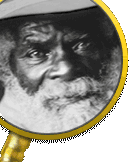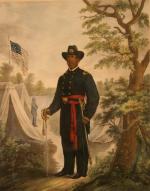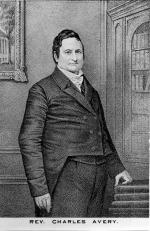Chapter Three: Helping Runaways
In March 1855, black residents in Pittsburgh heard that a slave catcher had entered their city with a female fugitive in tow. In response, they descended on the hotel dining room where the man, whose name was Slaymaker, was eating breakfast. There, they seized the woman, and quickly made plans to liberate her.
The outraged "slave catcher" then informed the city's mayor that he had been traveling by mutual consent with Caroline Cooper, a free black woman. The mayor called Martin Delany a leader of the local African-American community, to his office and had him meet with the unhappy visitor to review the woman's papers. Satisfied that the man was telling the truth, Delany arranged to have Cooper released and even provided Slaymaker with a letter certifying that he was not a slave catcher and should not be molested by other groups of free blacks or white abolitionists.
Martin Delany a leader of the local African-American community, to his office and had him meet with the unhappy visitor to review the woman's papers. Satisfied that the man was telling the truth, Delany arranged to have Cooper released and even provided Slaymaker with a letter certifying that he was not a slave catcher and should not be molested by other groups of free blacks or white abolitionists.
This story shows how dangerous nineteenth-century Pennsylvania could be, not only for fugitives, but for slave catchers. People today often imagine that escaped slaves and their supporters lived in constant fear of being captured or killed. The truth is more complicated. There was concern among Underground Railroad participants about their safety, but there was also a fighting spirit and a sense that on free soil, at least, they had the upper hand.
The leader, Martin Delany, was part of an organization in Pittsburgh called the Philanthropic Society. This Society provided coordination for Underground Railroad activities comparable to what the Vigilance Committee offered in Philadelphia. The western section of the state contained important land and river routes for runaways from western Virginia traveling North toward the Great Lakes and Canada.
Fugitives entering western Pennsylvania might first stop at LeMoyne House, the residence of a nationally known abolitionist doctor in Washington County. Passing through Pittsburgh under the care of Philanthropic Society members, runaways then typically headed toward Erie. Some stayed with a community of free blacks in Mercer County known as
LeMoyne House, the residence of a nationally known abolitionist doctor in Washington County. Passing through Pittsburgh under the care of Philanthropic Society members, runaways then typically headed toward Erie. Some stayed with a community of free blacks in Mercer County known as  Freedom Road. Others passed through the town of Meadville in Crawford County, where an African-American barber named
Freedom Road. Others passed through the town of Meadville in Crawford County, where an African-American barber named  Richard Henderson lived. A former slave himself, Henderson offered makeshift beds on the floor of his home for any fugitive needing a night's rest.
Richard Henderson lived. A former slave himself, Henderson offered makeshift beds on the floor of his home for any fugitive needing a night's rest.
In central Pennsylvania, the network for runaway slaves employed an even wider variety of escape methods. Businessman William Goodridge of York County owned freight cars that carried fugitives on an "upper-ground" railroad that was eventually destined for upstate New York. Cumberland County resident
William Goodridge of York County owned freight cars that carried fugitives on an "upper-ground" railroad that was eventually destined for upstate New York. Cumberland County resident  Daniel Kaufman hid wagonloads of escaping slaves in his barn and faced heavy fines from local courts for his actions.
Daniel Kaufman hid wagonloads of escaping slaves in his barn and faced heavy fines from local courts for his actions.
In a section of Harrisburg known as "Tanner's Alley," a group of free blacks formed a Fugitive Slave Society that sent what they called "packages" to Philadelphia on the real Reading & Pennsylvania Railroad. There was an American Indian named Daniel Hughes who carried fugitives on his lumber raft along the Susquehanna River to a place in Lycoming County now called
Fugitive Slave Society that sent what they called "packages" to Philadelphia on the real Reading & Pennsylvania Railroad. There was an American Indian named Daniel Hughes who carried fugitives on his lumber raft along the Susquehanna River to a place in Lycoming County now called  Freedom Road Cemetery. In
Freedom Road Cemetery. In  Union County, escaped slaves were hidden in a stable owned by a professor at nearby Bucknell University.
Union County, escaped slaves were hidden in a stable owned by a professor at nearby Bucknell University.
Most people who helped runaway slaves have no historical markers to commemorate their actions. In fact, it isn't really possible to be certain what routes fugitive slaves followed on their journey. What appears clear, however, is that people with widely different backgrounds from across Pennsylvania contributed to the success of the Underground Railroad. They did so at considerable risk, but most remained surprisingly defiant.
The outraged "slave catcher" then informed the city's mayor that he had been traveling by mutual consent with Caroline Cooper, a free black woman. The mayor called
This story shows how dangerous nineteenth-century Pennsylvania could be, not only for fugitives, but for slave catchers. People today often imagine that escaped slaves and their supporters lived in constant fear of being captured or killed. The truth is more complicated. There was concern among Underground Railroad participants about their safety, but there was also a fighting spirit and a sense that on free soil, at least, they had the upper hand.
The leader, Martin Delany, was part of an organization in Pittsburgh called the Philanthropic Society. This Society provided coordination for Underground Railroad activities comparable to what the Vigilance Committee offered in Philadelphia. The western section of the state contained important land and river routes for runaways from western Virginia traveling North toward the Great Lakes and Canada.
Fugitives entering western Pennsylvania might first stop at
In central Pennsylvania, the network for runaway slaves employed an even wider variety of escape methods. Businessman
In a section of Harrisburg known as "Tanner's Alley," a group of free blacks formed a
Most people who helped runaway slaves have no historical markers to commemorate their actions. In fact, it isn't really possible to be certain what routes fugitive slaves followed on their journey. What appears clear, however, is that people with widely different backgrounds from across Pennsylvania contributed to the success of the Underground Railroad. They did so at considerable risk, but most remained surprisingly defiant.











